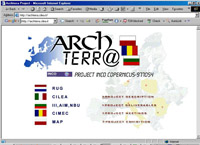
Figure 8: ArchTerra Project Homepage
It is easier for an archaeologist to browse through archaeological information in a language not known or little known if some keywords are translated and explained. Where can those terms be found? Archaeological terminology is sometimes missing in general language dictionaries, like any other speciality vocabulary. Terms might have meanings other than those used in daily language. A multilingual glossary offers such key terms and specific definitions to assist the reader or the translator. Glossaries and thesauri are often financed as part of cultural and scientific projects. How useful are these tools and how much work do they imply? Let us have a closer look at two examples of European co-operation.

Figure 8: ArchTerra Project Homepage
The Multilingual Glossary of Archaeological Terms was an ambitious goal in the ArchTerra Project: 'Extending the European Archaeology Web over Bulgaria, Romania and Poland', financed under the EU Copernicus Programme from the beginning of 1999 until the end of 2000 (van Leusen and Prinke 2001). The project's main objective was to include Central and Southeast European Archaeology in the European Archaeology Web (known as ArchWebs), previously covering western archaeology only, by establishing national web nodes in major heritage organisations from Bulgaria, Romania and Poland (Figure 8). This would improve access to archaeological information on a European scale and facilitate communication among professionals, museums, research organisations, universities and cultural heritage management bodies across the continent. Each national web node (Romania, Poland, Bulgaria, the last unfortunately non-operational now) is a gateway to legislation, organisations and people working in archaeology, publications, collections, databases and virtual exhibitions (Figure 9). The information is provided in national languages and English (in part).
Extending the mainly English-written European Web to new countries has meant also extending to new languages, with their specific diacritical signs (for Polish and Romanian) and different alphabets (for Bulgarian), as well as to new cultures and scientific traditions.

Figure 9: ArchWeb-Ro in English
A multilingual archaeological vocabulary was necessary as a base for a multilingual retrieval prototype and to map archaeological key terms and periods among languages. The list of essential terms regarding periods, site types, object types, materials and techniques, and iconography, in the languages of the partners in the project, aims to facilitate understanding of the multilingual archaeological resources available in the network. The first task was to establish a short list of restricted terms, with definitions and translations for each term. A draft list is online on the website of the Institute for Cultural Memory, one of the partners in the project. The more ambitious goal of organising the terms in a multilingual and multicultural thesaurus and to implement the thesaurus as a browseable retrieval interface (van Leusen 2000) was not reached. During the project, the Multilingual Glossary of Archaeological Terms for Periods and Cultures in Central and Eastern Europe was compiled - http://archweb.cimec.ro.
Among the attempts to develop multilingual terminologies is the English-French Glossary for Bronze Age Monuments (Barber 1995, CoE 1999). 'European Bronze Age monuments: a multilingual glossary of archaeological terminology' was a pilot project covering Denmark, France, the Netherlands, and the United Kingdom and contains 130 terms with complex definitions. It was also translated into Romanian (see http://archweb.cimec.ro).
© Internet Archaeology/Author(s)
University of York legal statements | Terms and Conditions
| File last updated: Tue Sep 27 2005